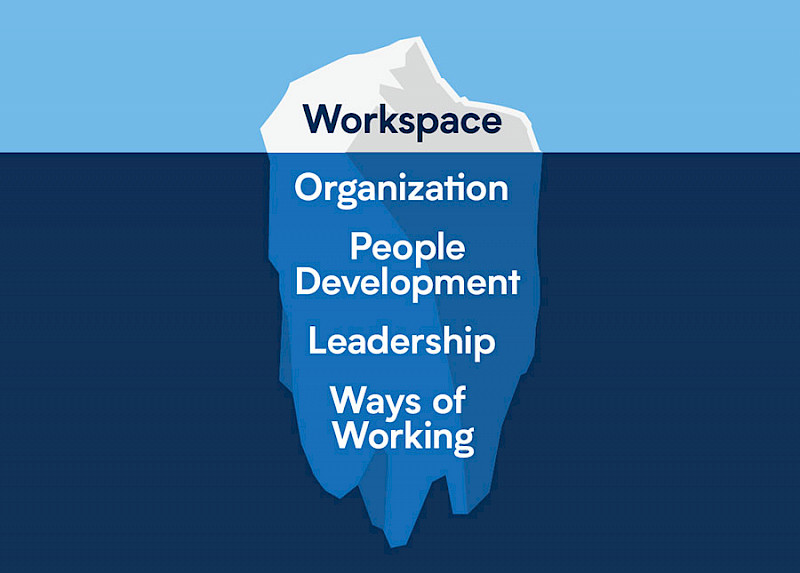The well-known architect Peter Ippolito considers the future office as a space that opens up many possibilities. However, one of the aspects Ippolito emphasises is that it can only be part of a comprehensive New Work approach.
The office of tomorrow is a place where values and the meaningfulness of what is done there are negotiated. In photographs of new office projects, one rarely sees workplaces, but mostly lounges, cafeterias, communication spaces. This impressively reflects how the perception of what we imagine work to be has changed. Of course, expected processes still have to be dealt with. But the freestyle is different: more communication, creative conversations, interplay of ideas, new ways of approaching ideas. This more liberal type of work is made possible by the change in conditions, such as the miniaturisation of tools or the no longer necessary fixation on the desk in the digital and online world. Let’s call it: from desk to collaboration.
The office as possibility space
Collaboration is only one aspect of the office. Concentration, communication or contemplation are also part of this new context of meaning(s) in the future office. Offering opportunities to find the right setting for activity, they are spaces with open concepts of use for different everyday office situations: quiet work, noisy discussion, retreat or exchange, group discussion versus focus work. Beyond the planned processes, they offer space for the unexpected and for the unplanned. Inside them, the decided in-between becomes a place for creative friction and innovation. In this way, the office becomes a place where I want to be, but don’t have to be.
The future office is thus a possibility space that adapts to changing needs in constant transformation. Instead of one-dimensional attributes, it is an invitation to continually update buildings and their use. They allow a hybrid variety of uses and can evolve with changing demands. This change must always be taken into account in all design phases. It is permanent – and it is accelerating.
The future office can only ever be one part of a comprehensive New Work approach. It is not enough to furnish a new headquarters with new lounge furniture or to reproduce the nostalgic images of old brick halls, workshops or repurposed spaces with lots of character and history. It is always about a holistic process. Identity, management and communication culture – the tools and processes of a company that are needed for this lead, in an all-connecting approach, together with the design of the spaces, to a consistent and thus credible attitude to work with which the employees can identify.
Let’s imagine an iceberg as an illustration:
The designed workspace is visible to all above the waterline. But New Work also includes leadership and corporate culture, organisational development and a company’s vision of the future. These are all equally important components of New Work, but they are less visible – and cannot be photographed. Without any comprehensive process structure, the famous change management, space will always remain just a collection of objects. It is exciting for us as designers to tackle this new field of design: from functional design to cultural design.

Like an onion: appropriation processes
The future office must provide answers to user needs. Employees want to be part of a social context, want to feel like they belong to the company they work for. On the other hand, organisational structures are also dissolving more and more. Classic departments are changing into matrix structures in which employees commute between individual poles. If the project requires it, colleagues are brought in from different areas – the boundaries are becoming more transparent, and this must also be expressed in spatial terms.
Please also read

That employees feel they belong to a corporate culture is a crucial issue in the design of workspaces. In this kind of appropriation, we talk about a kind of onion model: “I belong to this company, I belong in this building, on this floor, in this department, in this team, and this is my workplace”. Each of these levels has its own appropriation mechanism, which on the one hand has to be answered from within the company, from the respective structures and from the management culture. But it can equally be supported by the architecture. Without a process in which the entire team is involved, no sustainable and excellent result can be achieved. Space alone will never be able to meet the desired standard.
The awareness that designing spaces without designing the processes to reach them is highly unlikely to lead to the desired success, as well as the idea that our work is not the final point but the starting signal for change, fundamentally expands the idea of our work. We should see the corona period as a wake-up call not only for us as an industry, but for us as a society. And break out of entrenched patterns not only in the world of work. But beyond the expected answers and supposed truths, we should discover the potential of spaces in between, those free spaces that can release incredible energy if we renegotiate existing structures with a fresh mind.




 OFFICE ROXX
OFFICE ROXX 
